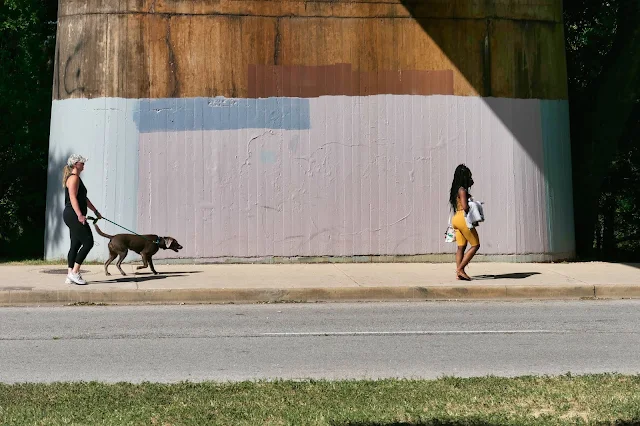For a long time I felt like I was too busy to address the stacks and drawers full of black and white negatives that reside all over the studio. I'd given my last flat bed scanner away to a non-profit years ago and, in the high volume work years if I needed a digital file from a cherished black and white negative I would just send it out to one of the two Austin photo labs (which are still in business) and let them handle it; for a price.
Now I find myself where everyone else is: with lots of time on my hands, no ready subjects to photograph right now, and re-considering my approach to looking for "gold" in my negative archives that I'd like to print or share. If I were fabulously wealthy I'd just put every slide, negative and piece of sheet film in boxes, drive it all over to the lab and have them go through piece by piece and create high resolution scans for me. But at $12 to $25 per image and with my realization that my interpretation for scanning is generally different than the scan philosophy of the labs I can't really justify spending tens of thousands of dollars to dig into negatives from yesteryear.
I'd gotten fairly competent at using an Epson scanner, purchased over a decade ago, to make scans of medium and large format prints but it really wasn't an optimum solution for 35mm negatives. Not enough resolution for really nice prints. And, when I was in the rush of business it just seemed more expedient to let someone else do the scanning.
Lately, three or four people who I follow on YouTube.com (like Sean Tucker) have proposed and demonstrated making good scans using their digital cameras combined with a macro lens. There are plug-ins for PhotoShop that make for easier conversion from the negative state to a positive image and I've seen a few tutorials of that process as well.
So, for all my home scanning of personal images I'm torn between just getting another inexpensive Epson flatbed scanner; like the Perfection V600, or trying my hand at "camera scanning."
Either way I'll have to spend some cash. I can buy the scanner for around $250 (including sales tax) but to do the lens approach I'll need to source a macro lens for the L-mount system. The lens that makes the most sense is the Sigma 70mm Art lens (macro) which would work on my Panasonic S system cameras but it's currently back-ordered everywhere. I'm sure I can find a Nikon or Canon macro and make do with an adapter. The solution from Leica for L-mount macro is a series of close-up lens attachments which you attach to a lens filter thread to allow for closer work. (Not optimal).
If this was for a series of paying jobs I'd try to source a more involved and capable scanner but even then without a dedicated 35mm scanner I'm not sure I'll get the data density I want in a file.
My inclination right now is to try my hand with the camera scan method (not really a scan since I'm doing a "one shot" image capture). This would involve ordering (and waiting for) a Sigma 70 Macro but I'm anxious to get started and might just buy a set of three different front-of-lens diopter attachments and at least experiment with one of the high resolution S1R bodies. If I can shoot negatives at 1:1 with that set up I can at least assure myself of getting the most information out of the negative.
The point of pain with this approach is getting the camera exactly planar to the film. I have a tripod with a side arm but I suddenly miss (for the first time) the sturdy, old copy stand I let go of years and years ago. We'll see if I'm bright enough to engineer some sort of workable substitute...
I'm not much worried about the post production side of things but I do worry about the capture. Sad though, if I'd have been doing this already a decade ago I would have a wide selection of adapters and slide duplicators to choose from.
The films I want to scan range from 35mm to 6x6cm, 6x7cm, 6x9cm and 4x5 inch sheet film. The larger the film size the easier I think the process will be.
I guess my question to the VSL readership is if you have tried the camera/macro lens/lightbox method yourself and if you have any pointers for a late arrival who suddenly finds himself ready to get some black and white files from yesteryear into the system. I'd love to hear from you.
My friend, Paul, shoots with Nikon D850s and bought one of the Nikon ES-1 Slide Copy Adapters which attaches to the front of a 60mm macro lens and seems to be the perfect solution for 35mm slides and 35mm negative stripes but I'm wary of buying multiple solutions for multiple film sizes if I don't have to.
Scanner or high res camera? Which way to go?
Final note for a stormy Tuesday morning: I ran the lake loop last week on a hot and humid afternoon and I have to say that running in the heat with a face mask on is just flat out painful. Makes me feel a bit claustrophobic and it also makes my brain imagine that breathing deeply is harder. I'm already thinking of workarounds and the best one I've come up with so far is to just be on the trail earlier in the day.
The perfect time, weather-wise, is around 6:30 am, for the start. All of a sudden this is starting to remind me of college swimming where the first practice of the day started at 5:45 a.m. ---mandatory --- five days a week. I thought I'd left the early stuff behind. Ah well, flexibility has its advantages.

















